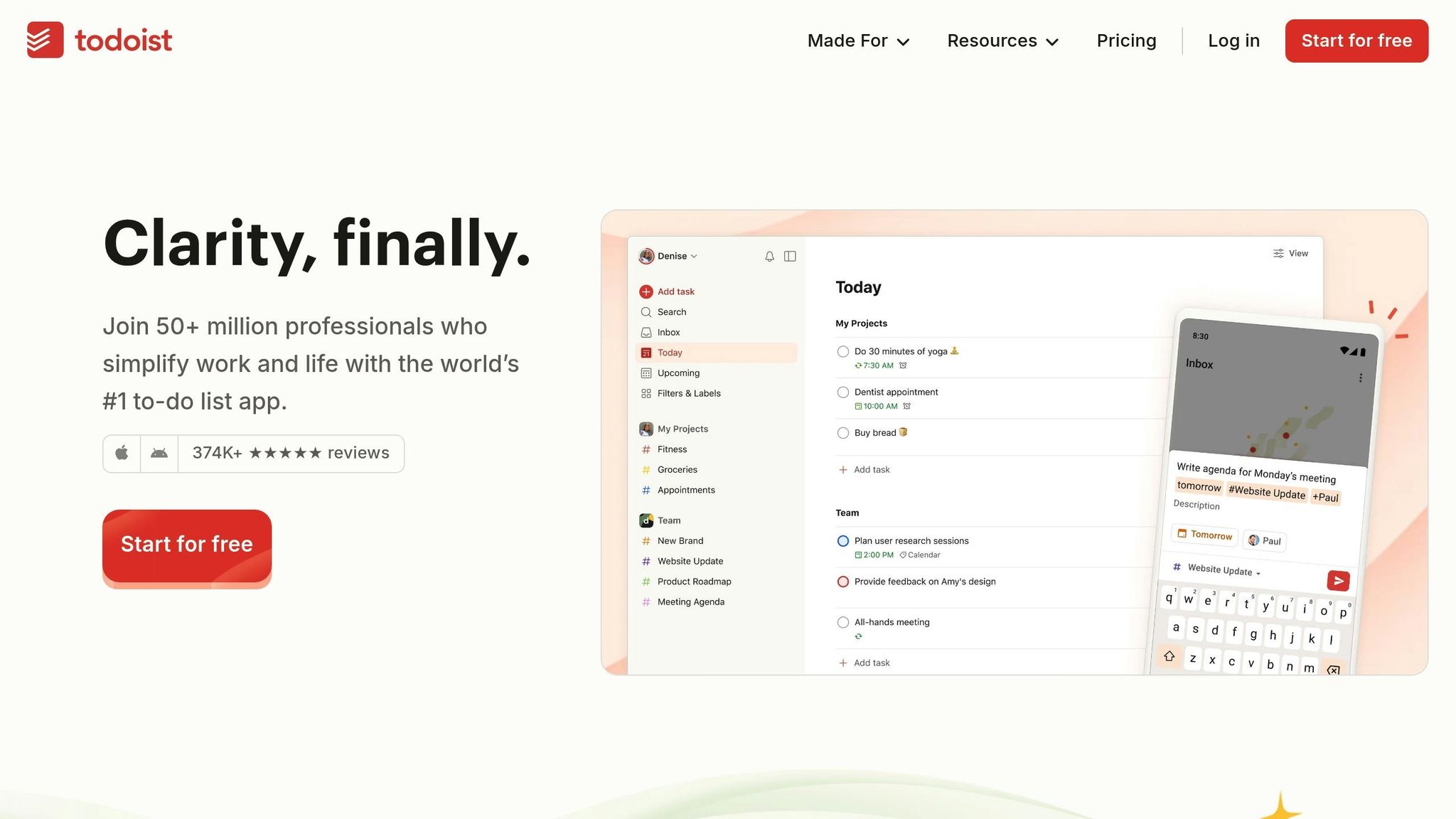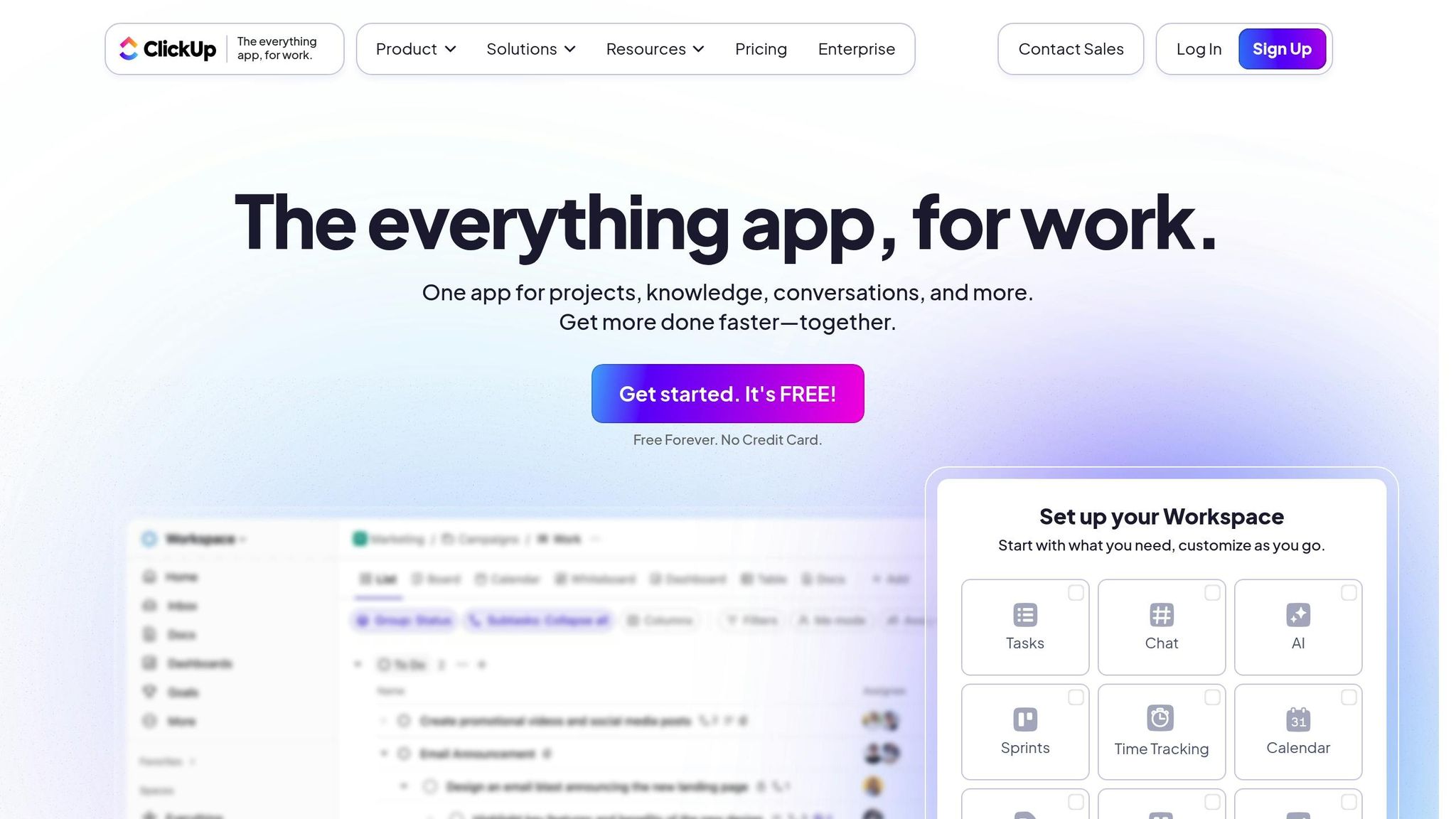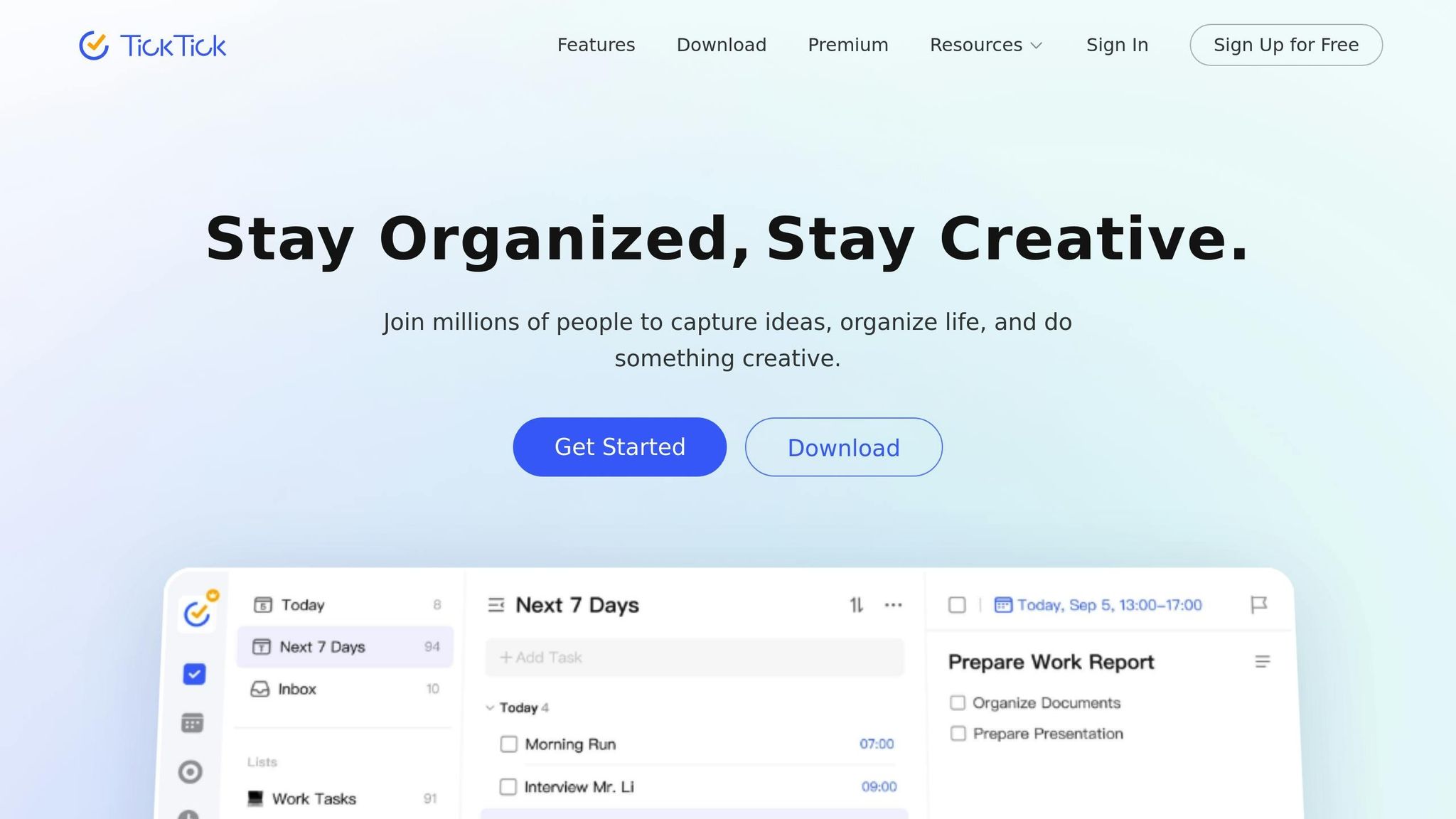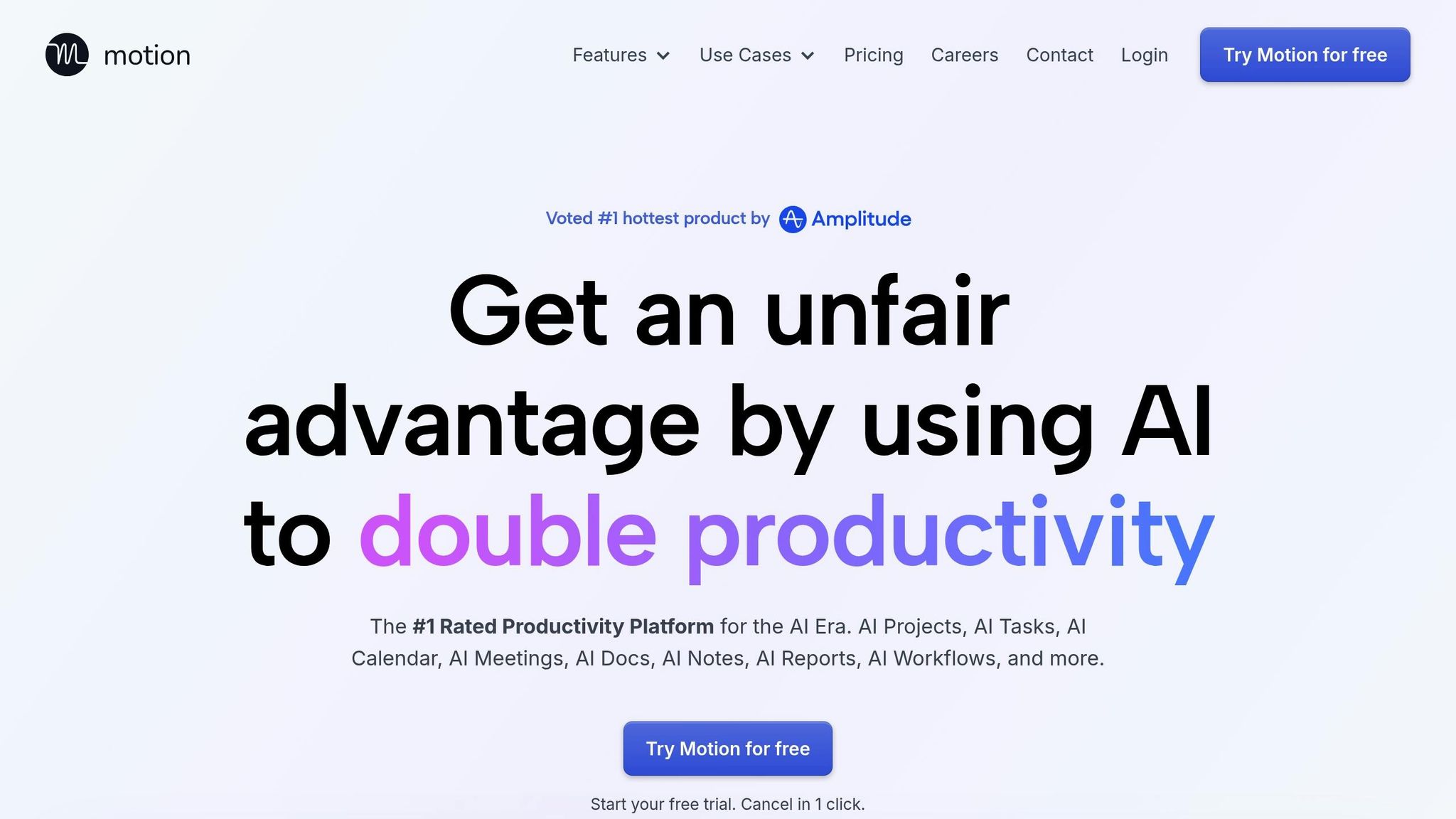Looking for a better daily planning app than Notion? Here's a quick rundown of five alternatives that cater to different needs:
- Growth Bundle: Combines 12 apps for task management, habit tracking, and wellness. Ideal for balancing productivity and mental health.
- Todoist: Simple, user-friendly, and great for task organization with natural language input and Google Calendar sync.
- ClickUp: Packed with features for project management, scheduling, and automation, though it may feel overwhelming for beginners.
- TickTick: Affordable and easy to use, with built-in calendars, time-blocking, and habit tracking for personal growth.
- Motion: AI-powered scheduling and task management, perfect for busy professionals who want automated planning.
Each app has its strengths, from wellness integration to AI-driven automation. Whether you're looking for simplicity, advanced features, or a focus on wellness, there's an option for you.
Quick Comparison:
| App | Best For | Key Features | Pricing |
|---|---|---|---|
| Growth Bundle | Productivity + Wellness | Task management, habit tracking, mindfulness | Free trial; price not listed |
| Todoist | Simple Task Management | Natural language input, Google Calendar sync | Free; Pro $4/month |
| ClickUp | Project Management | Advanced tools, time tracking, automation | Free; Paid plans available |
| TickTick | Budget-Friendly Planning | Calendar views, habit tracker, Eisenhower Matrix | Free; Premium $35.99/year |
| Motion | Automated Scheduling | AI-driven planning, real-time adjustments | $19/month |
Choose based on your priorities - whether it's simplicity, automation, or balancing work and wellness.
Top Daily Planner Apps & Tools
1. Growth Bundle

The Growth Bundle combines productivity and wellness tools into one subscription, making it easier to manage tasks, track habits, and focus on mental health and overall well-being. With an impressive 4.6-star average rating from over 190,000 reviews, it’s clear that users find it a valuable resource for organizing their lives.
This bundle includes 12 carefully selected apps, each designed to support different areas of your daily routine. Once you sign in with your Growth Bundle account, you can activate the subscription across all your devices, ensuring a smooth experience for productivity and self-care.
Task Management
At the heart of the bundle is the Growth app, a robust task management tool for daily planning. It allows you to add rich details to your tasks, such as due dates, priorities, durations, and even locations. The app organizes your workflow with default tabs like Inbox, Today, Upcoming, All, and Completed, while also letting you create separate project areas for work and personal tasks.
To boost productivity, the app features a built-in timer for tracking the time spent on tasks, a focus mode to block distractions during work sessions, and a quick action menu for frequently used functions.
Scheduling Tools
The Growth Bundle also addresses scheduling needs with tools designed for clarity and efficiency. The Timebloc app helps you plan your day by blocking time for events and routines, giving you a clear visual layout of your schedule. Additionally, Done tracks your habits, while Reflectly offers mood insights, helping you align tasks with your most productive times.
Integration Features
Seamless integration is a key focus of the Growth Bundle. The Growth app uses Apple’s CloudKit for automatic data syncing across devices linked to the same iCloud account. Beyond task management, the bundle connects with HealthView to sync fitness data from Apple Health and Apple Watch, merging your fitness goals and daily tasks into one streamlined system.
Pricing
The Growth Bundle is available through a single subscription fee that grants access to all 12 apps. While the exact pricing isn’t specified, a free trial is offered, allowing you to explore the ecosystem and decide which tools suit your needs best. This setup ensures you don’t have to pay for multiple individual apps to get the features you want.
Next, we’ll take a closer look at alternative apps that bring their own unique strengths to daily planning.
2. Todoist

Founded in 2007, Todoist stands out with its clear focus on task management, offering a simpler alternative to Notion's more expansive, all-in-one workspace approach. This streamlined design makes it a go-to choice for those who want an efficient tool for organizing their daily tasks without unnecessary extras.
Task Management
Todoist is all about keeping task organization straightforward and effective. Its simplicity ensures you can dive right in without spending time on complicated setups. One standout feature is its natural language processing for task entry. For example, typing something like "Call dentist tomorrow at 2pm" will automatically create a task with the correct due date and time. This intuitive design ensures you spend less time managing tasks and more time completing them.
Scheduling Features
When it comes to scheduling, Todoist truly shines. It handles recurring tasks effortlessly, allowing you to set up even complex patterns with minimal effort. The app also offers a seamless two-way sync with Google Calendar, meaning tasks with deadlines appear alongside your calendar events, and calendar entries can generate tasks in Todoist. Built-in reminders and notifications ensure you never miss a beat. These features make Todoist a reliable option for staying on top of your schedule.
Integration Options
Todoist connects with over 60 tools, making it an excellent choice for boosting productivity. Some of its most popular integrations include:
- Zapier: Links Todoist to hundreds of other apps.
- Pleexy: Combines tasks from other project management tools into Todoist.
- Google Calendar: Enables smooth two-way synchronization for tasks and events.
- Mailbutler: Lets you turn emails into actionable tasks directly.
Pricing
Todoist's pricing is competitive, offering a premium plan at $4 per month - half the cost of Notion's personal pro plan, which is $8 per month. For those who prefer to test the waters, the free tier provides enough functionality for basic task management, making it easy to try before committing to an upgrade. With its focus on simplicity and efficiency, Todoist delivers a reliable solution for managing tasks. Up next, we’ll take a closer look at ClickUp.
3. ClickUp

ClickUp is a project management platform designed to provide a ready-to-use, structured system. Unlike Notion, which requires users to build their workflows from scratch, ClickUp delivers a pre-set framework, making it a practical choice for those who want robust features without spending too much time on setup.
Task Management
ClickUp shines when it comes to task management. It offers features like advanced task creation, tracking, and assignment, all with minimal configuration. Pre-built options include task dependencies, custom statuses, and support for assigning tasks to multiple team members. However, this wealth of features can make the platform harder to learn, especially compared to Notion’s beginner-friendly interface.
Scheduling Features
When it comes to scheduling, ClickUp surpasses Notion’s basic calendar. It includes a built-in calendar with options for start and end dates, recurring tasks, and even AI-powered time-blocking for automated scheduling. The interactive Planner lets you drag and drop tasks directly onto the calendar and offers multiple views like Day, Week, and Month. You can also customize time zones and easily spot assigned, overdue, or backlog tasks. To top it off, ClickUp integrates smoothly with Google Calendar and Outlook Calendar for added convenience.
Automation Capabilities
ClickUp takes automation seriously. It allows users to create triggers and actions that automatically handle repetitive tasks. This reduces the need for third-party tools or manual workflows, which are often necessary when using Notion.
Integration Options
ClickUp connects with more than 1,000 tools, covering everything from development and design to communication and file management. Popular integrations include Slack, Microsoft Teams, Google Drive, Dropbox, GitHub, GitLab, Figma, and Adobe Creative Cloud. As ClickUp puts it:
"We're not just connecting different tools - we're reimagining how they should work together in the first place."
These integrations are two-way, meaning they can actively enhance your workflow. For instance, Zoom meeting recordings and transcripts can automatically attach to related tasks. ClickUp also supports direct imports from platforms like Asana, Trello, Jira, Monday.com, Notion, Basecamp, Wrike, and Confluence. This seamless integration ecosystem simplifies your daily planning and collaboration.
Pricing
ClickUp offers a cost-efficient solution by bundling scheduling, automation, and project management tools into one platform. Its extensive features and integrations can replace the need for multiple separate tools, helping streamline workflows and reduce expenses.
That said, users should note that ClickUp occasionally experiences performance lags and stability issues, which could affect the overall experience. Next, let’s explore how TickTick measures up in comparison.
sbb-itb-72d195f
4. TickTick

TickTick is a task management app that prioritizes simplicity and ease of use. Unlike Notion, which requires a more intricate setup, TickTick offers a streamlined approach, helping users get organized right away. Its focus on efficient task management makes it a go-to choice for those seeking powerful planning tools without the hassle of a steep learning curve. Let’s dive into its key features: task management, scheduling, integrations, and pricing.
Task Management
TickTick shines when it comes to managing tasks effectively. It’s designed for quick task capture and effortless organization. You can set up folders, lists, filters, tags, and priority levels with minimal effort. The interface is user-friendly, yet packed with tools for staying organized. Notable features include a Focus Timer to track the time spent on tasks and a Habit Tracker to support personal growth goals. Another standout is the Eisenhower Matrix, which helps users prioritize tasks based on urgency and importance. Dr. Yohama Caraballo-Arias praises these features, saying:
"The Eisenhower matrix to view priorities has been a brilliant innovation. I use TickTick every day, especially the habit tracker with reminders and the focus function. I highly recommend it to my colleagues and students."
Scheduling Features
TickTick offers multiple calendar views - monthly, weekly, daily, agenda, and multi-week - so you can always keep your schedule in check. The Multi-Week view lets you see two or three weeks at a glance, making it easier to plan ahead. Tasks can be color-coded by list, tag, or priority, helping you quickly distinguish between work and personal commitments. The app also supports a variety of reminders, including constant, email, repeat, and location-based alerts, ensuring you never miss a deadline. With smart time recognition, TickTick can interpret phrases like "meeting tomorrow at 3 PM" and automatically set tasks. You can also use voice input or quick-add widgets to speed up the process.
Integration Options
TickTick doesn’t just stop at task management - it also integrates seamlessly with other tools to enhance your workflow. It connects with productivity staples like Google Calendar, Gmail, Microsoft Outlook, Slack, and Amazon Alexa, allowing you to create tasks directly from emails or messages. Additionally, it works with platforms like Google Tasks, Microsoft To Do, Trello, and Evernote. Through Zapier, TickTick can link to thousands of other apps, automating repetitive tasks and syncing data across systems. As the TickTick Team notes:
"TickTick connects with daily apps you love to boost your productivity at work and life up to a new level."
These integrations make it easy to manage tasks and deadlines across multiple platforms without the need for manual updates.
Pricing
TickTick offers a free version that includes all the essential task management tools. For those looking to unlock more advanced features, the premium version costs $35.99 per year. Premium users gain access to calendar and timeline views, advanced filters, additional organization tools, and detailed task analytics. Shirley C., a retail professional, shares her thoughts on the premium version:
"The themes are elegant and I love being able to change the app icon to match my home screen. I would highly recommend the premium version; it's a bargain considering the utility you'll get."
With an impressive 4.9 out of 5 rating on the App Store from over 35,700 reviews and recognition as an Editors’ Choice app, TickTick has earned its place as a favorite among users. Its dedication to task management, rather than trying to do it all, makes it a solid choice for anyone looking to stay organized.
5. Motion

Motion sets itself apart by using AI to automate daily planning. Unlike Notion, which relies heavily on manual input for task and schedule organization, Motion’s AI takes over, handling scheduling and making real-time adjustments when meetings run over or new tasks pop up. This makes it a perfect tool for busy professionals who need an app that actively manages their time. Let’s dive into how Motion simplifies task management, scheduling, and automation to make daily planning more efficient.
Task Management
Motion’s task management revolves around AI automation, cutting down on manual work. The AI creates and prioritizes tasks by assessing project priorities, deadlines, dependencies, and the time each task requires. It then builds a daily plan optimized for your schedule, automatically updating it as priorities shift. Impressively, Motion’s AI achieves over 90% accuracy when generating projects. It can even turn text from documents into well-organized tasks and projects.
One standout feature is its ability to identify and prioritize urgent tasks automatically. The AI matches your workload with available time, flags tasks at risk of missing deadlines, and consolidates tasks from multiple apps into a single, streamlined list. This smart approach ensures nothing falls through the cracks.
Scheduling Features
Motion’s AI designs and adjusts your daily schedule, keeping your next priority front and center. It integrates seamlessly with Google Calendar, Microsoft Calendar, and Apple Calendar, making it easy to manage projects and tasks for both individuals and teams.
The app also includes tools similar to popular meeting schedulers. You can create custom booking pages that display your availability and preferred meeting times, complete with pre-meeting questions for attendees. If meetings run over or tasks take longer than expected, Motion’s dynamic rescheduling adjusts your schedule automatically to avoid disruptions.
Automation Capabilities
Motion goes beyond scheduling by automating task management, reducing decision fatigue. Its AI schedules and reschedules tasks and meetings based on your calendar, removing the stress of figuring out when to tackle each task. The results speak for themselves: Motion users report a 137% boost in productivity, with projects finishing 32% faster and efficiency increasing by 40%.
Users have shared how Motion has transformed their workflow. Matt J., a Business Analyst, said:
"Motion saved me from under-performing at my job, I feel so much less stressed and finally have a healthy work-life balance."
Integration Options
Motion connects effortlessly with key tools, offering native integrations with Google Calendar, Zoom, Gmail, Microsoft Teams, Google Meet, Microsoft Outlook 365, iCloud Calendar, and Siri. It also supports thousands of apps through Zapier, enabling flexible automations. For instance, when a deal in Pipedrive moves to "Contract Signed", Motion can automatically create a follow-up task.
For teams with unique needs, API integrations allow fully customizable workflows. Additional features like "Task from Email" and "Task from Siri" make it simple to capture tasks on the go, ensuring your workflow remains uninterrupted.
Strengths and Weaknesses
Each app shines in its own way, catering to different planning preferences and needs.
Growth Bundle combines wellness and productivity by integrating tools like Timebloc with mindfulness apps such as The Mindfulness App and Reflectly. This setup creates a well-rounded experience that balances task management with mental health. However, its focus on wellness might not suit users looking for advanced project management features, which sets it apart in this space.
Todoist simplifies task management with natural language commands and a user-friendly template system, making it great for handling complex projects. The clean interface ensures easy adoption. However, its reliance on Google Calendar for scheduling, instead of offering a built-in calendar, might be a limitation for some users.
ClickUp impresses with its extensive customization options and a wide range of features. It combines task management, goal tracking, document collaboration, and time tracking, while regularly rolling out updates. That said, the sheer number of options can feel overwhelming for newcomers, and some users report that its interface isn’t as responsive as simpler alternatives.
TickTick stands out as a budget-friendly choice at $35.99 per year, offering basic folder organization and a built-in calendar for time blocking. It also integrates smoothly with voice assistants, a feature missing in Todoist. However, its simplicity might not appeal to users needing advanced project management tools.
Motion is tailored for busy professionals, offering AI-powered scheduling that resolves conflicts and reschedules tasks in real time. At $19 per month for individuals, it provides a seamless automated experience. However, those who prefer manual control might find its heavy reliance on automation less appealing.
Here’s a quick comparison of each app’s strengths and limitations:
| App | Task Management | Scheduling Features | Automation Capabilities | Integration Options | Pricing |
|---|---|---|---|---|---|
| Growth Bundle | Basic task organization with Timebloc | Daily routine planning | Limited automation | Multi-device sync | Not specified |
| Todoist | Advanced with natural language processing | Google Calendar integration | Basic recurring tasks | 100+ integrations | Free, Pro $4/month |
| ClickUp | Comprehensive project management | Time tracking and calendar views | Workflow automation | Extensive third-party apps | Free, Paid plans available |
| TickTick | Simple with built-in calendar | Effective time blocking | Voice assistant integration | Calendar and basic apps | Free, Premium $35.99/year |
| Motion | AI-assisted task management | Automated scheduling with calendar sync | Advanced AI automation | Google, Microsoft, Apple Calendar | Individual $19/month |
Ultimately, the best choice depends on your specific needs. If wellness integration is a priority, Growth Bundle is a great option. For quick task capture and detailed organization, Todoist fits the bill. Teams needing robust project management tools will appreciate ClickUp, while budget-conscious users with a focus on time blocking might prefer TickTick. And if you’re a busy professional seeking automated scheduling, Motion is worth considering.
When deciding, think about your budget, team size, and whether you lean toward manual control or automation. Each app has its strengths and trade-offs, so align your choice with your workflow priorities.
Conclusion
Choosing the right app depends on how you like to plan and organize your day. Here's a quick breakdown of what each option brings to the table:
- Growth Bundle: Perfect for those who want to blend wellness with productivity. It’s great for users who aim to balance their work and personal well-being.
- Todoist: A straightforward tool with a clean design, making it easy to capture and organize tasks without any fuss.
- TickTick: A budget-friendly option that combines a built-in calendar with time-blocking features for efficient planning.
- ClickUp: Offers powerful project management tools and customization options, though it might take some time to master.
- Motion: Designed for busy professionals, it uses AI to automate scheduling and adapt to changes seamlessly.
Each app has its own strengths, so pick the one that fits your priorities and style best.
"Efficiency is doing things right; effectiveness is doing the right things." - Peter Drucker
FAQs
How does the Growth Bundle combine wellness and productivity tools to improve daily planning?
The Growth Bundle brings together wellness and productivity tools into a single, easy-to-manage subscription. It offers features like mindfulness exercises, mood tracking, gratitude journaling, and goal setting - tools that are crafted to promote mental clarity and emotional balance.
By combining organization with self-care, this approach not only helps users stay on top of their tasks but also supports their overall well-being, making daily planning both efficient and rewarding.
How does Motion's AI-powered scheduling stand out from traditional task management apps?
Motion takes scheduling to the next level with its AI-driven approach, moving beyond simple task lists. It adjusts your schedule in real time, reshuffling priorities based on shifting deadlines, your availability, and current workload. The result? You stay focused on the tasks that truly count.
What sets Motion apart from traditional apps is its ability to craft detailed project plans while smartly optimizing your time slots. This intelligent system keeps you organized, helps you hit deadlines, and makes reaching your daily goals feel effortless.
What makes TickTick a great choice for daily planning, especially for those on a budget?
TickTick shines as a daily planning app thanks to its budget-friendly pricing and a solid lineup of features. The free plan covers the basics, offering tools like task management and reminders - perfect for anyone keeping an eye on their expenses. For those who need a bit more, the premium plan is reasonably priced and unlocks extras like multiple calendar views, task duration tracking, and time blocking.
Its user-friendly design and handy features, such as habit tracking and calendar integration, make it a great fit for freelancers, educators, and small business owners. TickTick provides an efficient way to stay on top of tasks, improve productivity, and keep goals in check - all without breaking the bank.
